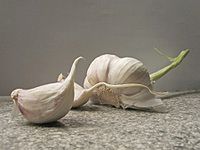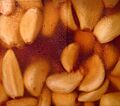Garlic facts for kids
Quick facts for kids Garlic |
|
|---|---|
 |
|
| Garlic plants | |
| Scientific classification | |
| Kingdom: | |
| Division: | |
| Class: | |
| Order: | |
| Family: | |
| Subfamily: |
Allioideae
|
| Tribe: |
Allieae
|
| Genus: | |
| Species: |
A. sativum
|
| Binomial name | |
| Allium sativum |
|
Garlic (scientific name Allium sativum) is a type of plant in the onion family, called Allium.
It is closely related to onions, shallots, leeks, chives, and Chinese onions. People have used garlic for thousands of years. It comes from Central Asia and northeastern Iran. Garlic has been a popular seasoning all over the world for a long time. The Ancient Egyptians knew about it. They used it for both food flavor and as a traditional medicine.
Contents
What is Garlic?
Garlic is a plant that grows from a bulb. It can grow up to 1.2 meters (4 feet) tall. This plant is quite tough and can grow in many places. Its flowers have both male and female parts. Bees and other insects help to pollinate garlic flowers.
Where Garlic Comes From and Its Types
Allium sativum can grow wild in areas where it has spread naturally. Some plants called "wild garlic" in Great Britain are actually different species. These include Allium ursinum, Allium vineale, and Allium oleraceum. It is hard to find the original wild plant that common garlic came from. This is because many types of garlic grown today cannot produce seeds. They might all come from a plant called Allium longicuspis. This plant grows wild in central and southwestern Asia.
In North America, Allium vineale (also called "wild garlic") and Allium canadense (known as "meadow garlic") are common weeds in fields. What people call elephant garlic is actually a type of wild leek. It is not a true garlic. Single clove garlic, also known as pearl or solo garlic, first grew in the Yunnan province of China.
Garlic in Europe
Many types of garlic in Europe have special protection. This means they are known for coming from a specific area.
How to Grow Garlic
Garlic is easy to grow and can be planted all year in warm places. While garlic can grow from seeds, most garlic is grown by planting single cloves. In colder areas, cloves are planted in the autumn. This is usually about six weeks before the ground freezes. They are then harvested in late spring or early summer. You need to plant the cloves deep enough. This stops them from freezing and thawing, which can cause mold.
Garlic plants can be grown close together. Make sure there is enough room for the bulbs to grow big. They also grow well in pots that are deep enough. Garlic likes loose, dry soil that drains well. It also needs sunny spots. It can grow in many climates. When you pick garlic for planting, choose large bulbs. Planting large cloves with good space helps the bulbs grow bigger. Garlic plants prefer soil with lots of organic material. However, they can grow in many different soil types.
There are two main types of garlic: hardneck and softneck. The best type to grow depends on how far from the equator you are. Hardneck garlic grows better in cooler places. It has larger cloves. Softneck garlic grows better closer to the equator. It has smaller, tightly packed cloves.
Garlic scapes are the flower stalks. They are removed so the plant's energy goes into growing the bulb. These scapes can be eaten raw or cooked.
Garlic Plant Problems
Garlic plants are usually strong. They are not often bothered by many pests or diseases. Some people say garlic plants can keep rabbits and moles away. However, tiny worms called nematodes and certain fungi can harm garlic. Once these are in the soil, they can stay there for a long time. Garlic can also get pink root disease. This usually does not kill the plant. It makes the roots turn pink or red and stops them from growing well. Other problems include leek rot or downy mildew. The larvae of the leek moth can also attack garlic. They dig into the leaves or bulbs.
How We Use Garlic
Cooking with Garlic
Garlic is used all over the world. People love its strong flavor as a seasoning or condiment.
The bulb of the garlic plant is the part most often used. Except for single-clove types, garlic bulbs are usually made of many fleshy parts called cloves. Garlic cloves are eaten raw or cooked. They are also used for medicine. They have a strong, spicy flavor. This flavor becomes much milder and sweeter when cooked.
Other parts of the garlic plant can also be eaten. The leaves and flowers (small bulbs) on the plant's head are sometimes eaten. They taste milder than the bulbs. People usually eat them when they are young and tender. Young garlic is sometimes picked early, like a scallion. It is sold as "green garlic." If green garlic grows past the "scallion" stage but does not fully mature, it can make a garlic "round." This is a bulb like a boiling onion, but it does not separate into cloves. It gives food a garlic flavor and smell without being too spicy. Green garlic is often chopped and stir-fried or cooked in soup or hotpot. This is common in Southeast Asian and Chinese cooking. It is very common and cheap there. Also, the young flower stalks (scapes) of hardneck and elephant garlic are sometimes sold. They are used like asparagus in stir-fries.
Parts of the garlic plant that are not usually eaten include the thin "skin" covering each clove and the root cluster. The papery skin is usually removed before cooking. However, in Korea, young whole garlic heads are sometimes cooked with the tender skins still on. The root cluster at the bottom of the bulb is the only part not usually eaten in any form. Another way to cook garlic is to cut the top off the bulb. Then, drizzle olive oil (or other oil) over the cloves. Roast them in an oven. The garlic becomes soft. You can then squeeze the cloves out from the root end of the bulb. In Korea, garlic heads are heated for several weeks. This makes a product called black garlic. It is sweet and syrupy. It is now sold in many countries.
Garlic can be put on different kinds of bread, usually with butter or oil. This makes classic dishes like garlic bread, garlic toast, bruschetta, and crostini. The flavor changes depending on how it is cooked. Garlic is often used with onions, tomatoes, or ginger.
Young scapes are soft and can be eaten. They are also called "garlic spears" or "stems." Scapes usually taste milder than the cloves. They are often used in stir-frying or cooked like asparagus. Garlic leaves are a popular vegetable in many parts of Asia. The leaves are cut, cleaned, and then stir-fried with eggs, meat, or other vegetables.
Garlic powder tastes different from fresh garlic. If you use garlic powder instead of fresh garlic, 1/8 teaspoon of powder is about the same as one clove of garlic.
Garlic Around the World
Garlic is a very important part of many dishes. This includes food from eastern Asia, South Asia, Southeast Asia, the Middle East, northern Africa, southern Europe, and parts of Latin America. Latin American seasonings often use garlic in sofritos and mofongos.
Oils can be flavored with garlic cloves. These garlic-infused oils are used to season all kinds of vegetables, meats, breads, and pasta. Garlic, along with fish sauce, chopped fresh chilis, lime juice, sugar, and water, is a key part of dipping fish sauce. This is a very popular dipping sauce in Indochina. In East and Southeast Asia, chili oil with garlic is a popular dipping sauce, especially for meat and seafood. Tuong ot toi Viet Nam (Vietnam Chili Garlic Sauce) is a very popular sauce in North America and Asia.
In some types of cooking, young garlic bulbs are pickled. They are soaked for three to six weeks in a mix of sugar, salt, and spices. In eastern Europe, the shoots are pickled and eaten as a snack. Laba garlic is made by soaking garlic in vinegar. It is a type of pickled garlic served with dumplings in northern China to celebrate the Chinese New Year.
Garlic is very important in Middle Eastern and Arabic cooking. It is in many foods. In countries like Jordan, Palestine, and Lebanon, garlic is traditionally crushed with olive oil, and sometimes salt. This makes a Middle Eastern garlic sauce called Toum (meaning "garlic" in Arabic). Toum is often eaten with chicken or other meat dishes like shawarma. Garlic is also a key part of hummus. Hummus is an Arabic dip made of chickpeas, tahini, garlic, lemon juice, and salt.
Lightly smoked garlic is used in British and European cooking. It is especially good for stuffing poultry and game, and in soups and stews.
Mixing garlic with egg yolks and olive oil makes aioli. Garlic, oil, and a thick base make skordalia. Blending garlic, almonds, oil, and soaked bread makes ajoblanco. Tzatziki, which is yogurt mixed with garlic and salt, is a common sauce in Eastern Mediterranean cooking.
Images for kids
-
Harvesting garlic, from Tacuinum Sanitatis, 15th century
-
Garlic bulbs and cloves for sale at a market in Bangkok
-
Blended garlic confit
See also
 In Spanish: Ajo para niños
In Spanish: Ajo para niños

















